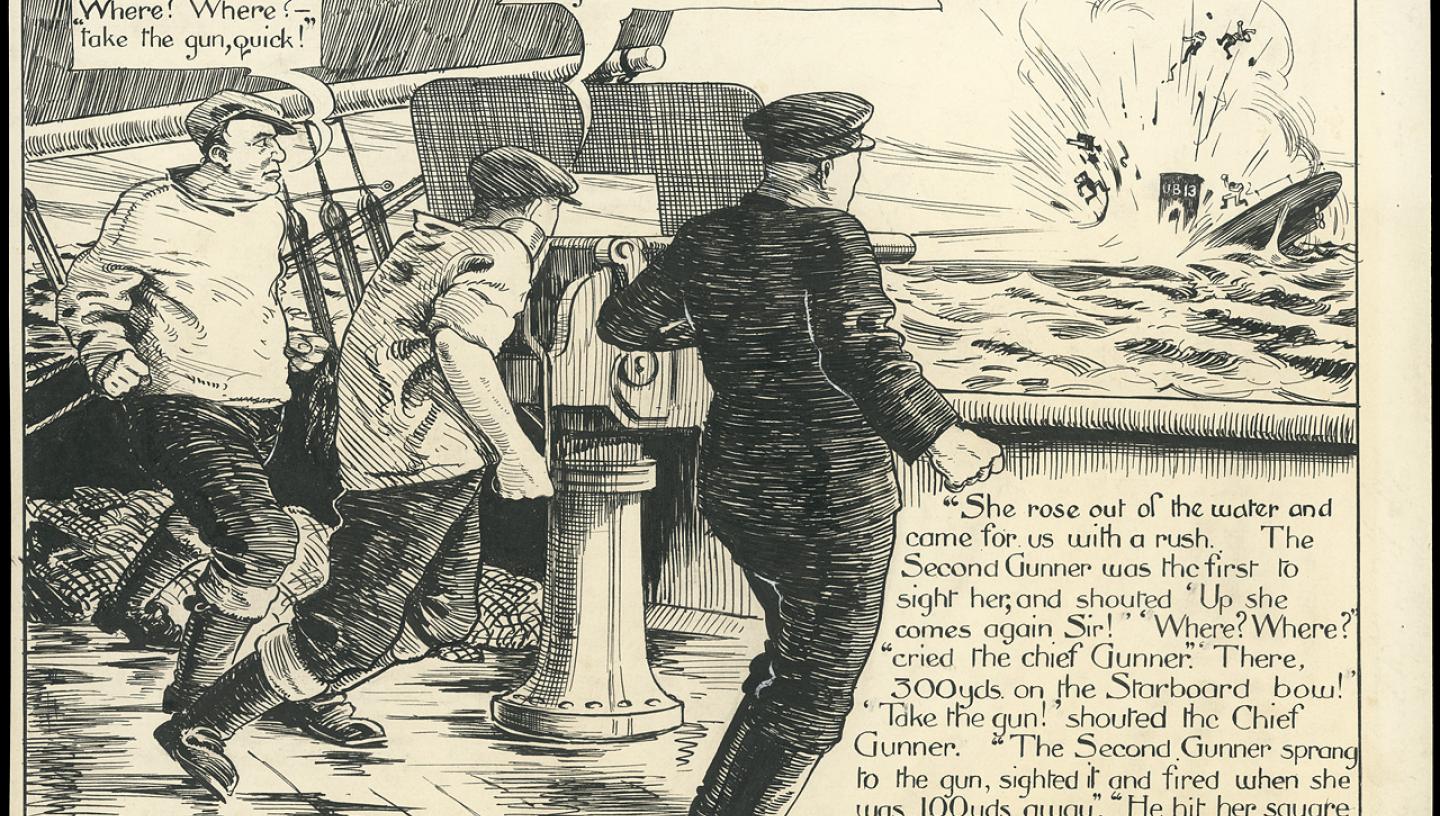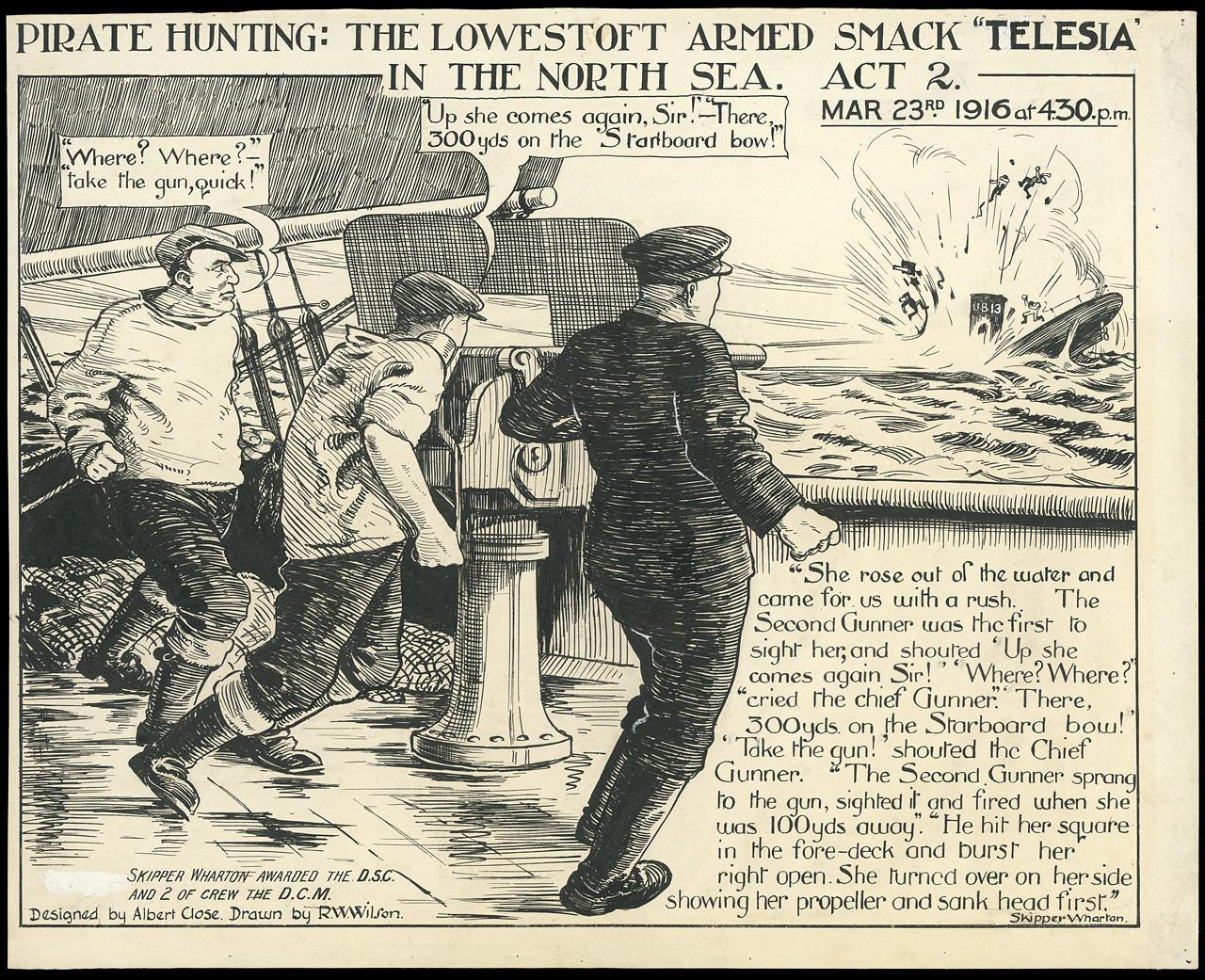
Essential Information
| Location |
National Maritime Museum
|
|---|---|
17 Oct 2014
October's item of the month is dynamic and dramatic, resembling a cartoon from the pages of a Boy's Own magazine publication. The gun crew on the deck of a British ship engage and destroy a German U-boat. The result of the action is devastating, as the submarine disintegrates, scattering the bodies of several sailors into the water.
This drawing was published by the journalist Albert Close and is a good example of the type of propaganda material that was issued during the conflict by the British government. The encounter between the Telesia and German submarine or ‘U-Boat’, UB-13 did actually happen and the propaganda message promoted by the illustration would serve as encouragement to those fearful of the hidden menace of the enemy commerce raiders: the triumph of the small but gallant fishing boat over her malevolent foe. However, evidence of the incident indicates a different story to that shown in the cartoon.
During the First World War, both the British and German governments utilised propaganda to mould and control the attitude of their respective country’s populace. On the outbreak of hostilities, British propaganda was the responsibility of the War Propaganda Bureau under the journalist Charles Masterman. Prominent artists were often commissioned to produce images that highlighted successful actions undertaken by the armed forces.

The two vessels shown in the cartoon were the British fishing smack Telesia and a German submarine, the UB-13. The Telesia, whose home port was Lowestoft, was a 46-ton vessel built in 1911. However, she had been converted into what was called a Q-Ship as part of the war effort. These ships, filled with concealed armament (in this case a 3-pounder gun), were used as decoys to draw U-boats into surface action against seemingly vulnerable merchant and fishing vessels. She was commanded by skipper W.S. Wharton and had a crew of eight.
The introduction of the Q-ships made operations far more dangerous for the U-Boats as any unarmed and vulnerable-looking merchant vessels could potentially be equipped with concealed armament. Records show that very few submarines were actually lost in combat against Q-Ships but they acted as a significant deterrent.
The UB-13 was a UB1-type coastal submarine of 142 tons, launched in 1915 and she served all her career as part of the Flanders Flotilla, which patrolled the North Sea. She was commanded by Oberleutnant Arthur Metz, had a complement of 17 men and was armed with torpedoes in two bow tubes and a deck-mounted 8 mm machine gun. UB-13 was a veteran of 36 North Sea patrols and had previously sunk nine vessels (including 7 fishing smacks). On 16 March 1916, the submarine torpedoed and sunk the 13,911-ton neutral Dutch ocean liner Turbantia, the largest neutral ship lost during the war, an act which caused much angry criticism universally.
On 23 March 1916, the Telesia was fishing in the North Sea, over 30 miles south east of Lowestoft, when the crew sighted a German U-boat. According to the eyewitness report, the submarine 'rose out of the water and came for us with a rush', dispatching a torpedo which missed and passed astern of the smack. In response, the Telesia fired several shots from her deck gun before and after the submarine surfaced.
These shots appeared to hit the conning tower and the foredeck of UB-13 and 'burst her right open. She was seen to turn over on her side and sink by the bows, showing her propeller as she foundered'. This description left little doubt that the U-Boat had been sunk. Wharton was awarded the D.S.C. and two of the crew of the Telesia received the D.S.M. for their brave conduct in the confrontation with the German submarine.
However, intriguingly official records show that the UB-13 went on to sink two ships after the date when she was apparently destroyed in the Albert Close cartoon! These were the Norwegian steamship Memento and the Danish sailing vessel Proven, on 31 March 1916 and 12 April 1916 respectively. The records also state that two weeks later on 23 April 1916, UB-13 failed to return to Zebrugge from a patrol off the mouth of the Thames and was presumed lost with all hands. She was believed to have hit a contact mine on an anti-submarine net or possibly sailed into a British minefield.
There is a further twist. On the same day as UB-13 is recorded as being destroyed, the Telesia (by this time called the Hobby Hawk) is credited with destroying U-Boat UC-3, using towed mined nets off Zebrugge. This cannot be true, however, as UC-3 was not reported missing until 27 May 1916.
So was it actually UB-13, rather than UC-3, that was finally sunk by the Telesia a month after their first encounter depicted in the Albert Close cartoon? Perhaps we shall never know the full facts of the story but, whatever the cause of her demise, UB-13 would not trouble merchant shipping again…